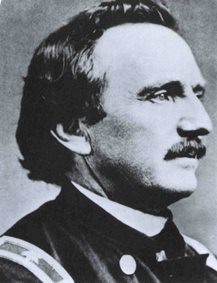Lumbering, shaggy masses of broad-shouldered, spindly-legged buffalo covered the western grasslands in the years before the Civil War. They provided the Plains Indians with food, clothing, and shelter. The vast herds seemed limitless to astounded travelers. Yet, even then, voices warned of their impending destruction. Frequently those voices belonged to Army Engineers.
In the 1840s, two Topographical Engineers, Lieutenant William B. Franklin on the Platte River and Lieutenant James W. Abert on the Arkansas, heard Indians tell of the decline of the buffalo. Both men wrote at length in their reports of the serious effects the demise of the buffalo would have on tribal life.
Abert, after meeting with Chief Yellow Wolf of the Cheyenne in July 1846, noted “It seems but just, since the people of the U.S. have driven off the buffalo by continually traveling through the country, by multiplying roads, and by killing great numbers, that the Government of the U.S. should aid these Cheyennes.”

As Lieutenant Abert, an accomplished artist, learned about the buffalo from the southern Cheyennes,
he also added their likenesses to his sketchbook.
 |
| Capt. William F. Raynolds |
He also cited the devastating impact caused by careless persons whose campfires were destroying pastures. “This winter, the buffalo have almost deserted the river,” Abert wrote in his journal, “there is no grass for them; and the poor Indian, forced by the cold season to take refuge in the timber that alone grows on the streams, must now travel far away from the village to get meat enough for his subsistence. There should be a law to protect these noble pasture grounds.”
Only a few years later, as the western migration swelled with gold-seeking Forty-Niners, Captain Howard Stansbury saw fewer buffalo than Franklin and Abert had reported. The herds, Stansbury noted, “have fled before the advancing tide of emigration. Driven from their ancient and long-loved haunts, these aboriginal herds, confined within still narrowing bounds, seem destined to final extirpation at the hands of men.”
Captain William F. Raynolds, on his way to the upper Yellowstone in 1859, was appalled by the wholesale slaughter of buffalo cows for their skins. “Another generation,” he predicted, “will witness almost the entire extinction of this noble animal.” Regrettably, Raynolds’ prophecy came true. The warnings of the Engineer explorers went unheeded. The buffalo came within a hair’s breadth of extinction, and the impact on American Indian culture was incalculable.
* * *
September 2004